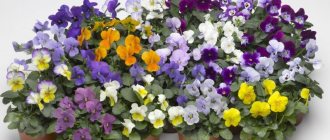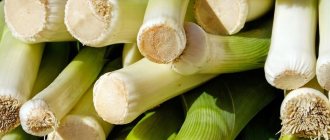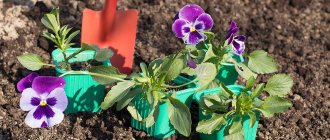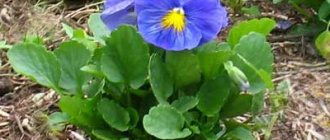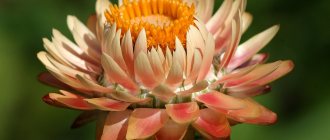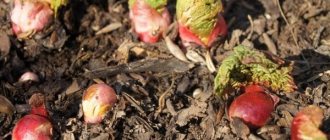Pansies are incredibly beautiful flowers that can become a real decoration of the garden. They are quite unpretentious, quickly adapt to open ground, and get used to climatic conditions.
In order for the sprouts to be strong and healthy, it is necessary to plant the seedlings correctly and in a timely manner.
How to grow pansy seedlings? This is what this article is about.
Sowing time
When to plant pansy seedlings? The time for planting seedlings largely depends on when the pansies will be transplanted into open ground. Here two factors play a key role:
- Climatic conditions of the region. In central Russia, the temperature changes to positive from the end of March, so already at the end of April you can proceed to transplanting to open ground. In Siberia this time falls at the beginning of June.
- Moon calendar. Many years of experience of gardeners proves that plants planted in favorable conditions are healthier, stronger and less susceptible to disease. For each month there are certain favorable and unfavorable days.
Each package of seeds indicates the approximate time during which the seeds will germinate and become good sprouts suitable for replanting . Based on this figure, the climatic features of the region and the lunar calendar, an approximate time is selected.
When to sow pansies for seedlings? In warm regions - from mid-February, in areas with prevailing low temperatures - from mid-April
Collecting seeds
How to proceed:
- Tricolor violet planting material begins to be collected at the end of summer or at the beginning of autumn.
- Faded buds turn into small boxes, inside which seeds form.
- Carefully cut off the formation with grains, pour the seeds onto the fabric.
- Dry the collected planting material at room temperature.
- Subsequently, tricolor violet seeds are stored in bags and in the refrigerator.
- The variety, variety, and date of seed collection must be indicated on the packaging.
Pansies will help add bright colors and tenderness to your summer cottage, balcony and flowerbed next to the house. Spectacular appearance Tricolor violet has taken root well in regions with temperate climates; the plant is unpretentious and can be cared for by gardeners with or without experience. After studying the material in the article, it will be easier to figure out when to sow Pansy seedlings and what conditions the Viola plant prefers.
How to grow pansy seedlings at home? More useful tips in the next video:
Variety selection
Pansies are herbaceous plants of small height - about 10-30 centimeters. They are annual or perennial, and depending on the time of planting, they bloom in spring or summer.
Pansies have the following botanical features:
- usually grow in small bushes;
- peduncles are smooth, have single buds;
- petals of various sizes;
- The color is also different, it can be from yellow to deep black.
There are complex patterns on the surface of the petals - a distinctive feature of pansies.
Depending on the botanical characteristics, varieties of pansies are distinguished. To date, there are about 400 of them.
Let's take a closer look at those that are most often used to decorate a garden.
About pests
It is impossible to ignore such a topic as garden pests. Pansies are unpretentious plants, but if care is improper, diseases cannot be avoided.
Blackleg can affect not only young plants, but also already grown flowers. This happens if the bushes grow too close to each other or weeding is not done in a timely manner. Damage also occurs when there is excessive soil moisture.
Diseased plants are removed, watering is stopped for a while, and wood ash is added to the ground.
Varieties of Pansies
Pansies are propagated by seeds for seedlings. The most commonly used varieties are:
- Vittroka is a perennial variety whose plants reach a height of 20-30 centimeters. The leaves are oval-shaped and bright green in color. The buds are large, reaching a diameter of 10 centimeters and have different colors: white, pink, dark red, purple, blue, light blue.
- Tricolor is a wild species. This variety is most often used in folk medicine to create infusions and decoctions. It is distinguished by small buds with a diameter of up to two centimeters in white, blue, purple or blue shades.
- Fragrant. As the name implies, this variety has a delicate and pleasant aroma. Plants reach a height of 15 centimeters and have small, up to two centimeters in diameter, purple or white buds. This type is often used in perfumery to produce esters.
- Horned is a perennial variety whose plants reach a height of 20-25 centimeters. It has flat, oval, elongated leaves of a rich emerald color. The flowers are small, up to 5 centimeters in diameter, and blue, cyan or violet in color. Hybrid varieties have also been developed, where red, yellow or white buds predominate.
- Williams is a variety obtained by crossing two others - horned and Wittrock. Refers to a biennial species. Plants reach a height of 30 centimeters, have leaves of regular shape and buds of various colors: yellow-burgundy, white-blue, yellow.
- Sororia or “moth viola” is a perennial variety, the plants reach a height of 30 centimeters, have small buds up to three centimeters of a delicate blue-violet hue.
- Spotted is distinguished by large buds with corrugated petals. This variety grows well in dark places with a lack of sunlight. The main difference between this variety is the presence of small spots on the petals.
It is necessary to choose a variety based on planting conditions: soil quality, abundance or lack of moisture and sunlight. Usually, recommendations are written on the packaging of the seeds.
Additional tips and tricks
Pansies often refuse to bloom due to late sowing of seedlings. If the timing is delayed, you will have to sow the seeds directly into open soil. It is advisable to use a spreading bed.
To achieve lush flowering, it is necessary to promptly cut off fading flowers. Large varieties of viola are grown in waves for this purpose. After the first flowering, the bushes are pruned; the second appearance of buds is noted in the fall. Moreover, the autumn wave turns out to be more abundant and longer lasting. The horned viola is considered the most luxuriantly blooming.
For the winter, pansies are insulated, covered with spruce paws, hay, and special material.
Growing viola seeds for seedlings is not difficult. The main thing is to follow simple rules for caring for seedlings, water and feed them in a timely manner, and protect them from infection and insects.
How to plant seedlings
Seedlings begin to be planted in mid-February and continue until the end of April. As already mentioned, everything depends on specific climatic conditions and the lunar calendar. The following days are considered the most favorable:
- February: 7,8, 12, 14;
- March: 1, 2, 15, 16, 23, 28;
- April: only two days – 6 or 17;
- May: 8, 12, 15, 16, 17, 18.
And on the following days it is recommended to refuse planting:
- February: 2, 8, 9, 10, 16, 22, 23, 24, 25;
- March: 2, 8, 9, 10, 16, 23, 24, 25;
- April: 1, 7, 8, 9, 15, 22, 23, 24, 30;
- May: 6, 7, 8, 14, 21, 22, 23, 30.
In general, the rule is simple: do not plant anything during the full moon or new moon, as well as three days before and after.
Following this recommendation will allow you to grow healthy plants that will become a real decoration of the garden. But there are other tips.
Let's take a closer look at them.
Soil preparation
It is recommended to plant pansies in special soil, which has the required chemical composition, the required concentration of substances and fertilizers. When choosing a substrate, pay attention to the following parameters:
- chemical and acid composition. The soil should contain: deciduous and turf soil, compost, peat and river sand;
- genuine quality certificate;
- shelf life of the soil.
You can plant seedlings in ordinary plastic pots or special peat containers
Popular varieties
The most popular varieties include Pansies with a long flowering period and bright, intricately colored flowers.
White
An elegantly simple flower with snow-white petals. It is enlivened by a small yellow core. The representative of the species is Wittrock. Blooms well in sun and shade. Easily survives transplantation in the flowering state.
Blue boy
On low bushes (up to 15 centimeters) there are bluish-blue flowers with a yellow core.
Rua de Negri
It is characterized by long flowering, which, under favorable conditions, lasts from May to October. The yellow eye in the center stands out brightly against the very dark velvet background. The flower size is 4-6 centimeters, the petals have a small flounce along the edge.
Red
Lovers of red flowers will appreciate this variety of Pansies. The petals are a rich red color, on which the dark center is almost invisible. The size is impressive - almost 7 centimeters.
Jupiter
Small bushes are strewn with flowers (up to 12-17 pieces). The bright purple center of the petals is surrounded by a white border that widens at the top of the flower. It is pleasing to the eye all summer long and survives the winter well.
Beaconsfield
Lord Beaconsfield has two types of petals. The lower ones are deep purple, with an even darker middle, the upper ones are white, with lilac veins. They bloom for a long time, maintaining brightness and contrast.
Saint Canute
The bush blooms with a large number of flowers (up to 20). The color of the petals is different - a combination of different tones of orange and red.
Shalom Purim
A fancy violet that combines orange-red and purple tones. Flowers with ruffled petals, thick and full. More luxuriant when grown in the shade.
Tiger Eyes F1
Amazing brindle flowers. On a yellow-orange background there are dark stripes that densely cover all the petals. The yellow core is surrounded by an equally dark circle. Flowers with a diameter of 3-4 centimeters strew the small bush.
Cassis F1
Lovers of dark tones will appreciate the Cassis hybrid. A thin white border runs along the edges of the dark purple petals, bringing the flower to life. Winter-hardy hybrid.
Arkwright Ruby
The flower is a bright red color with a very dark spot on the lower petals. Looks great in combination with light Pansies.
Balmont Blue
An excellent option for lovers of blue violets. The color of the petals ranges from blue to bright blue. There are veins of a darker or lighter tone. A beautiful climbing bush with a large number of shoots.
Purple Duet
The upper and lower petals of the viola differ in color. Together they form a beautiful pink-burgundy flower.
Rosina
An elegant flower with bent petals, looking like a small bird in flight. Color – pink, thickening towards the base. Smells nice.
Charlotte
A perennial with a low bush that grows up to 15 centimeters. The color of the petals is purple. It blooms better in sunny areas; in shading, the number of buds decreases.
Tsar
A popular variety with fragrant light purple flowers. In flower beds they are grown in a group with other plain violas.
Freckles
One of the most unpretentious varieties of Pansies. Blooms in May. Purple specks run across the white field of petals. The bushes grow up to 20 centimeters.
Royal Robe
The color of the petals of this viola variety varies from light purple to deep purple. The center of the petals is shaded with light and dark lines. The petals are slightly bent towards the stem.
Red Giant
Viola Red Giant is suitable for lovers of purple-red shades. Flowering starts in June and lasts all summer, until September. Pansies stand beautifully on long stems, towering above the bush.
Hansa
The medium-sized bushes of Hansa are dotted with bright blue flowers of simple shape, thin and graceful.
Caesar
The fragrant flowers of Caesar have purple petals, the bush is low, and the flowering period is long.
Red charm
The petals are a distinct red-purple color, with small veins of a darker tone, the middle is yellow. The stem is creeping, takes root easily, and young bushes develop quickly. Smells pleasant and can grow in the shade of trees. Blooms in late spring and autumn.
La France
La France flowers have a classic shape, a deep purple hue, and a yellow center. They quickly occupy the entire area of the pot and grow well.
Rumba
The bushes grow up to 25 centimeters. The flower is large, the color of the petals varies, and the seeds are often sold as a mixture.
Pearl Falls
An excellent option for hanging in flower pots. An abundance of flowers and bright greenery fill the walls of the pots. The color of the petals is white and purple. The edges and middle are dark, white spots in the center of the petals. Blooms until late autumn.
Sparkler
An ampelous variety, looks good in flowerpots and on alpine slides. The color of the petals is yellow and burgundy.
Amber Kiss
The leader in popularity among lovers of warm shades. Viola Amber Kiss is painted in an unusual bronze-orange color. It has a long flowering period and is used for cultivation all year round. Flowers - 3.5-4.2 centimeters.
Froze chocolate
The flowers of this hybrid are yellow-chocolate in color and grow up to 3 centimeters. The bushes are even, do not stretch upward, and form a thick mat on the flower beds. They tolerate high temperatures well and bloom profusely in the shade.
Bambini
Children will love Bambini's cheerful flowers. On the light field of the petals, eyelashes are drawn in the form of dark strokes. The color of the petals varies in white and yellow. The flowers are small and bloom in May-June.
Cats
Cats blue pansies have a complex blue coloration. The upper petals are of a lighter shade; the lower petals have blue strokes that look like veins. The bright yellow center enlivens the blue palette. The flowers are large - 9-10 centimeters, flowering lasts from June to October.
Mammoth
The Mammoth series of violas is distinguished by a wide variety of colors. All species are large-flowered and grow up to 9-10 centimeters. Among the representatives there are pansies of one color (white, red, purple) and with fancy patterns (Pink Berry).
Flowers of the Mammoth series are resilient, grow quickly, and easily tolerate drought.
Seed preparation
Seeds are usually purchased at gardening stores. They are produced in individual paper packages, which must be tightly sealed and free from defects and damage. The seeds inside must be whole and uniform, without spots, the smell of rot or other symptoms of disease.
If home-made seeds are used for planting, then before planting they are soaked overnight in a weak solution of potassium permanganate. It will help disinfect and remove harmful substances
Selection of capacity
As already mentioned, seedlings can be planted in various plastic containers. Ideal for:
- disposable cups;
- special containers for seedlings;
- one large container, but with subsequent planting of mature sprouts in individual containers;
- peat cups or tablets that decompose in the soil;
- trays.
The container must have drainage holes . If there are none, you need to make them yourself - just pierce the bottom.
Drawer with drainage grid
Planting a plant
The high decorative value of pansies in open ground directly depends on the planting location. Although the plant is quite shade-tolerant, in dense shade it degenerates: the flowers become smaller, lose their saturation, the stems of the plant stretch out and fade. The flowering time of such plants is significantly reduced.
Planting viola in open ground
The second condition for the luxurious flowering of pansies is the soil. Viola does not tolerate dry, rocky, sandy soil. This flower develops well in fertile soil, with a high content of nutrients and moisture. Viola care is minimal.
How to plant pansies correctly: planting and care
Pansies - planting and care are not difficult: you can plant the plants directly from the seeds into the soil. To do this, the soil is loosened and the seeds are planted shallowly. Watering the crops is done carefully using a watering can with a fine strainer so as not to wash the seeds out of the soil. Shoots in open ground appear on the 7-10th day.
To speed up flowering, care should be taken in advance to use the seedling method, when seeds are sown in a greenhouse or greenhouse in advance. This agrotechnical technique allows you to obtain abundantly flowering bushes much earlier than when sowing with seeds. Growing seedlings begins in February. Boxes with seeded viola are kept for a week in a dark place. With the emergence of seedlings, the boxes are moved to the brightest place. Caring for seedlings involves timely watering and hardening. Pansy seedlings are planted in the ground in mid-May. Flowering can begin within a month.
An example of decorating a summer cottage with pansies
Important! Watering the seedlings must be carried out regularly, preventing the earthen ball from drying out or becoming waterlogged.
Viola is an unpretentious plant. Caring for her is not difficult. The plant requires regular watering, but it does not respond well to stagnant water in the garden bed.
Important! To prolong the flowering of the viola bush and preserve the decorative appearance of the plant, faded flowers must be removed regularly. Pinching stimulates the development of side shoots, which increases the number of decorative flowers.
Planting scheme
The planting process is simple, and for everything to go well, it is recommended to adhere to the following scheme:
- Buy seeds and soil.
- Prepare containers for planting and make drainage holes in them.
- Fill the container with soil and water it with a solution of water and fungicides. This will prevent the occurrence of root system diseases or pest infestations.
- Bury the seeds into the soil 5-7 millimeters.
- Spray with water at room temperature from a spray bottle.
- Cover with cling film or polyethylene to create a greenhouse effect.
- Place containers in a warm place.
- Open the film every day so that the surface is ventilated and the seeds do not rot.
- After the first sprouts have appeared, they can be planted in individual containers, if initially the seedlings were in a common container. Usually within 2-3 weeks.
- Once every 4-5 weeks you can fertilize the seedlings.
If the weather in the region is predominantly cloudy, then ultraviolet lamps can be used as an additional light source.
How many days does it take for pansies to sprout?
The first shoots may appear in about a week. The better the care, the sooner they will sprout, since the seeds need sufficient moisture and sunlight. You can speed up seed germination by moving the tray to the south side, where there is more warmth and light.
Watering flowers
With the onset of hot days, the root system may begin to dry out due to its close location to the top layer of soil. To avoid this, the viola needs to be watered regularly, but without fanaticism. Excess moisture, as mentioned above, the plant will not like, and the roots begin to rot. At average temperatures, watering is carried out up to three times a week, but when it gets hot, the flowers can be watered daily.
Pansies care and cultivation
Growing and caring for seedlings
As already mentioned, the better the care of the seedlings, the faster the seeds will germinate and the healthier the sprout will be, the better it will adapt to open ground. The key care factors are the following:
| Temperature | In order for the seeds to germinate, it is necessary to create a sufficiently high temperature - about 22-25°C. That is why it is recommended to cover the container with film. After the first shoots have appeared, room temperature of 16-20°C is enough for the plant. |
| Lighting and supplementary lighting | Pansies require sufficient sunlight. If it is not enough, the sprouts must be illuminated with ultraviolet lamps. |
| Humidity and watering | Seeds and small sprouts must be regularly treated with warm water at room temperature from a spray bottle. |
| Feeding | As soon as 3-4 leaves appear from the seeds, you can feed the soil with nitrogen or phosphate supplements. To do this, use special low-concentration liquid additives, which can be found in a gardening store. Instructions for application are different for each composition; they are written on the bottle. |
| Picking seedlings | After the first 3-4 leaves appear, the seedlings need to be transplanted from a common tray into individual containers. |
| Pinching | After 8-10 petals appear, you can pinch the plant from the top. This will allow you to get more green mass. |
| Diseases and pests of seedlings, how to fight | Most often, pansies are susceptible to the following types of diseases:
|
Proper care will allow you to get beautiful pansies that will become a real decoration of your garden or local area.
Diseases and pests of seedlings, how to fight
When plant care rules are not followed, various types of problems develop:
- Powdery mildew. A dangerous disease, negative manifestations are visible on the leaves, signs of damage: white bloom, wilting of plant parts, poor growth. Damaged areas are removed and promptly treated with a solution of Bordeaux mixture (concentration - 1%).
- Rust. Brown spots are found on the foliage. It is necessary to get rid of the infected parts of the plant. Treatment is effective, as in identifying tricolor powdery mildew on violets.
- Rot. The lesion appears on the roots and above-ground parts of the plant. Remove damaged parts of the flower, apply fungicides (Funlazol, Topaz, Skor), and ensure proper watering.
- Blackleg. Occurs when the soil is very wet. Reduce watering, use Fitosporin.
- Spider mite. A thin cobweb is found on the leaves and buds, and the plant dries out. The flower is washed under water and treated with insecticides two or three times (at a certain interval, according to the instructions).
- Root-knot nematode. A dangerous parasite settles on the roots, leading to the death of pansies. Sodium nitrate is used to kill the pest.
- Mother of pearl. The pest eats leaves and buds. The drugs Citcor and Kinmiks are used to kill insects.
- Aphid. The tiny insect lives on the green part of the plant and actively feeds on the sap of the flower. Viola is treated with chemical insecticides, using Aktara, Mospilan, Konfidor, Aktellik.
Improper care of viola seedlings includes the following factors:
- watering excessively;
- the plant is in a shaded area;
- non-compliance with temperature conditions;
- increased air dryness;
- the gardener uses hard water to water the soil;
- flowers are planted in soil that is not suitable for acidity or soil composition.
When treating a plant with chemicals, be sure to wear protective clothing: gloves, gauze mask, goggles, headscarf. Do not eat, drink or smoke while working with chemicals. Upon completion of disinfection, wash your hands and face with soap and rinse your mouth with water. You can consume food and water 2 hours after treatment.
Planting in open ground: terms and rules
Planting seedlings in open ground requires various knowledge and skills from the gardener. It is important to do this correctly so as not to damage the root system, spoil or ruin the plant.
The easiest way to transplant is from peat cups or tablets. They just need to be placed in the ground and watered on top. Peat decomposes in the ground, so there is no need to remove sprouts from it.
It is more difficult to transplant from plastic trays and cups. Let's consider this issue in more detail.
Preparing seedlings
If the seedlings were transplanted correctly, the sprouts will quickly adapt to the new location and get used to the conditions of the area and climate. The first thing the preparation begins with is hardening the young shoots. This is a rather important stage, since it will prevent the death of seedlings from temperature changes.
About two weeks before the proposed transplantation, the seedlings should be taken outside for 3-4 hours, gradually increasing this time to 6-7 hours. It is recommended to leave it in a sunny, warm place
Also, two weeks before planting, young shoots can be fed. To do this, plant fertilizers, for example, liquid vermicompost, are added to the soil.
Selecting a location
Pansies love a warm place. At the same time, an abundance of sunlight can lead to the appearance of spots on the leaves and drying out of the plant. Therefore, the ideal place for a flower is partial shade, a place where it is mostly light in the morning and cloudy in the afternoon.
A place under other flowers, large in height, subshrubs and shrubs, and trees is well suited for planting.
As for the soil, it should be:
- nutritious;
- loose;
- breathable;
- drained.
In order to obtain soil suitable for planting, it is recommended to dig up the territory of the vegetable garden or garden, add charcoal and humus to the soil
If the site is dominated by heavy clay soils, then they dig up with the addition of sand, peat and mineral fertilizer, for example, nitroammofosk.
Landing technology
The technology for transplanting seedlings to open ground is as follows:
- Make holes at a distance of 20-30 centimeters.
- Put a small amount of vermicompost into each and mix it with the soil that is in the hole.
- Cut the glass and carefully remove the sprout along with the surrounding lump of earth.
- Place in the hole, cover with soil and press down.
- Water the planted plants with water.
After a few days, it is recommended to treat the soil surface with complex fertilizer. This will protect young shoots from diseases of the root system and pests
Main problems
Let's look at the most common problems when growing pansy seedlings.
Seeds don't sprout
The reason for the lack of viola seedlings may be:
- non-viable seeds;
- excessive penetration into the soil;
- heavy soil.
You have to be patient - sometimes sprouts appear within a month. If you want to sow new seeds, you need to take these errors into account.
The shoots are thin and lie down
The main reasons for the thinning of viola sprouts:
- Planting density. The plants are cramped and there is not enough space. Thinning is carried out very carefully.
- Lack of light. In low light conditions, you need to use electric lighting for Pansy seedlings.
Plants may not have enough nitrogen, they weaken and fall. Fertilize with nitrophoska (NPK complex).
The seedlings withered as soon as the glass was removed
When the cover is removed from the viola, the water balance and temperature around the seedlings change. The microclimate inside the greenhouse is different than in the room. It is necessary to establish proper watering and move the containers to a cool place without direct sunlight.
Another cause of wilting can be root rot that has spread from contaminated soil. It is necessary to inspect the viola sprouts and, if necessary, water them with fungicides.
Flower care
After planting, it is necessary to carefully care for the young shoots so that they do not wither, but grow healthy and strong. It is recommended to do the following:
- water the pansies in a timely manner, but do not overwater them;
- after watering, it is recommended to slightly loosen the surface of the moisture;
- remove weeds in a timely manner;
- feed and fertilize once or twice a season;
- trim dead flowers, remove unhealthy parts of the plant.
As you can see, caring for pansies is not much different from caring for other plants. Therefore, the gardener will not have any problems.
Growing seedlings
For early flowering, it is better to plant pansies as seedlings. Most species tolerate replanting even with buds and flowers. Many gardeners, when planting is delayed, admire the bright violets at home.
How to plant correctly
For planting violas, use new or used containers 10 centimeters deep, carefully treated with fungicides. A drainage layer is laid on the bottom, the soil is lightly compacted, spilled and left until the moisture is completely absorbed. Small grooves (up to 5 millimeters) are made on the surface. Dry viola seeds are scattered from a pinch or from a sheet of paper into the ground, trying to maintain a distance of 0.6-1 centimeter.
Cover with dry soil, rubbing it in your palms. Water with warm water from a spray bottle. The container is covered with film or glass and left in a dark place at a temperature of 15-20 °. Viola shoots appear in 6-10 days.
Soil selection
Ready-made soil mixture for violets is the best choice for planting. When preparing the soil for viola yourself, combine humus, peat, sand and fertile soil in equal parts. Before using your own soil, it is disinfected by calcination or freezing.
Seed preparation
Pansy seeds are small and difficult to work with. Most people plant seed without germination, since viola sprouts are easy to break. Before planting, the seeds are soaked for an hour in a solution of a stimulant - Zircon or Epin. Next, they are dried by laying them out on paper.
Watering
After germination, the containers are transferred to a lighted place. Watering is carried out as the soil dries out - pansies do not tolerate excess moisture and puddles. Water carefully, at the root, with a small watering can or sprayer.
Top dressing
Violas need fertilizing no more than once every 2 weeks. Use special fertilizers for violets or ordinary mineral complexes with potassium, phosphorus, and nitrogen. It is important not to exceed the standards recommended in the instructions.
Picking
Picking Pansies is carried out when growing 2 leaves. The seedling is removed from the container with a lump of earth, and the central root is carefully trimmed. This stimulates the growth of lateral roots and rapid establishment.
Overgrown seedlings can be pricked again, deepening them to the leaves and without bending the roots.
Topping
After 4-6 permanent leaves have grown, the top of the viola is pinched to form side shoots. This is done in the absence of sun, at a temperature of 15-18 °.

